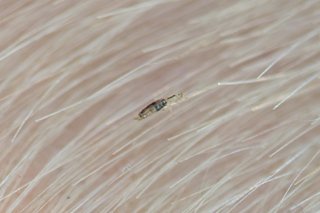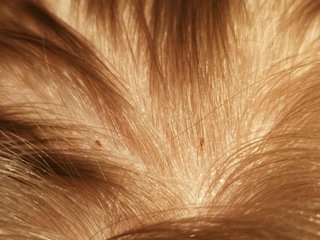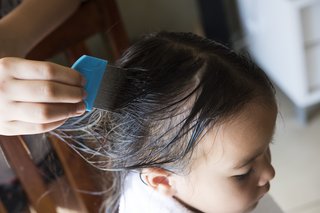Head lice and nits are very common in young children. They live in either clean or unwashed hair. They usually spread through head-to-head contact.
Head lice are insects. Nits are the empty egg cases left behind when the lice hatch.
Check if it's head lice


Head lice can make your head feel:
- itchy - you may see marks on your child's head from scratching
- like something is moving in your hair
Lice and nits can be difficult to spot in the hair.
The only way to be sure someone has head lice is by finding live lice or eggs.
Eggs containing developing lice stick to the hair shafts near the scalp. They are grey or brown.
Nits are empty egg cases left behind when the lice hatch. You will find them a little distance away from the scalp.
Treating head lice
Remove head lice by wet combing as soon as you spot them. You do not need to see your GP.
Check everyone in the home. Treat others on the same day if they have head lice.
Treatment for adults is the same as treatment for children.
There's no need for children to stay off school if they have head lice. You may wish to tell the school or creche if you find living lice in your child's hair. This can help stop the lice spreading to others.
Wet combing
You can remove lice and nits by wet combing. Try this before anything else.
You can buy a special fine-toothed comb (detection comb) online or from pharmacies to remove head lice and nits.
How to comb for head lice
To wet comb your child's hair:
- Wash the hair using an ordinary shampoo.
- Cover the hair with plenty of conditioner - the conditioner stuns the head lice making it easier to remove them.
- Use a regular comb or brush to detangle the hair and separate into sections.
- Comb each section with your fine-toothed detection comb - make sure the teeth of the comb slot into the hair at the roots and draw the comb down to the ends of the hair with every stroke.
- Check the comb for lice after each stroke, and remove them by wiping on a tissue or rinsing the comb - do this until no more appear on the tissue.
- Rinse out the conditioner - this can take between 10 and 30 minutes depending on the length of the hair.
Wet comb your child's hair every 3 to 4 days for at least 2 weeks. You can stop when no lice are seen for 3 combing sessions in a row.
Wet combing is:
- effective
- unlikely to irritate your child's skin

Medicated lotions and sprays
Ask a pharmacist for advice if you’ve tried wet combing for 2 weeks, but your child still has head lice.
They may recommend a head lice treatment such as a lotion or spray. These kill head lice. You can buy them from pharmacies, supermarkets or online.
Check the pack to see if the product is safe for you or your child.
Non-urgent advice: Talk to your GP, midwife or obstetrician if:
- you or someone in your family is pregnant and want to use a head lice treatment
Head lice should die within a day of treatment. Lotions and sprays come with a comb to remove dead lice and eggs.
You may need to repeat some treatments after a week to kill any newly hatched lice.
If lotions or sprays do not work, speak to a pharmacist about other treatments.
Preventing head lice
You cannot prevent head lice. Head lice spread from head-to-head contact. But there are some things you can do to reduce the risk of spreading lice or getting reinfected.
Do
-
tie back long hair
-
wet comb your child's hair regularly with a fine-toothed comb - this will help catch them early
-
wash your child's pillow cases in a hot wash if they had head lice - there can be a risk of reinfection from pillow cases but the risk is low
-
if your child has head lice wash their combs and brushes in hot water
Don't
-
do not use medicated lotions and sprays as a way to prevent head lice - these can irritate your scalp
There is no evidence that you need to clean your house or classroom - or to wash all bedclothes. Head lice only live on humans.
